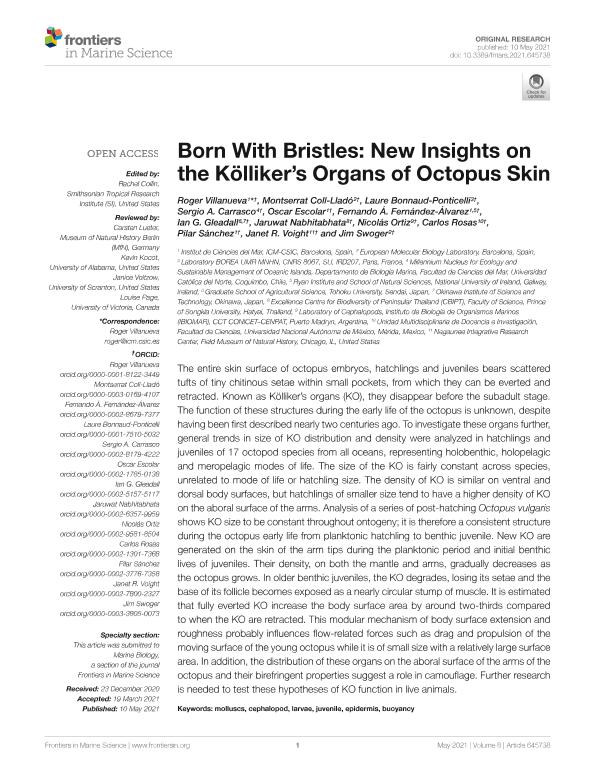Artículo
Born With Bristles: New Insights on the Kölliker’s Organs of Octopus Skin
Villanueva, Roger; Coll Lladó, Montserrat; Bonnaud-Ponticelli, Laure; Carrasco, Sergio A.; Escolar, Oscar; Fernández Álvarez, Fernando Ángel; Gledall, Ian G.; Nabhitabhata, Jaruwat; Ortiz, Nicolás ; Rosas, Carlos; Sánchez, Pilar; Voight, Janet R.; Swoger, Jim
; Rosas, Carlos; Sánchez, Pilar; Voight, Janet R.; Swoger, Jim
 ; Rosas, Carlos; Sánchez, Pilar; Voight, Janet R.; Swoger, Jim
; Rosas, Carlos; Sánchez, Pilar; Voight, Janet R.; Swoger, Jim
Fecha de publicación:
03/2021
Editorial:
Frontiers Media
Revista:
Frontiers In Marine Science
e-ISSN:
2296-7745
Idioma:
Inglés
Tipo de recurso:
Artículo publicado
Clasificación temática:
Resumen
The entire skin surface of octopus embryos, hatchlings and juveniles bears scattered tufts of tiny chitinous setae within small pockets, from which they can be everted and retracted. Known as Kölliker organs (KO), they disappear before the subadult stage. The function of these structures during the early life of the octopus is unknown, despite having been first described nearly two centuries ago. To investigate these organs further, general trends in size of KO in octopus, distribution and density were analysed in hatchlings and juveniles of 17 octopod species from all oceans, representing holobenthic, holopelagic and meropelagic modes of life. The size of the KO is fairly constant across species, unrelated to mode of life or hatchling size. The density of KO is similar on ventral and dorsal body surfaces, but hatchlings of smaller size tend to have a higher density of KO on the aboral surface of arms. Analysis of a series of post-hatching Octopus vulgaris shows KO size to be constant throughout ontogeny; it is therefore a consistent structure during the octopus early life from planktonic hatchling to benthic juvenile. New KO are generated on the skin of the arm tips during the planktonic period and initial benthic lives of juveniles. Their density, on both the mantle and arms, gradually decreases as the octopus grows. In older benthic juveniles, the KO degrades, losing its setae and the base of its follicle becomes exposed as a nearly circular stump of muscle. It is estimated that fully-everted KO increase the body surface area by around two-thirds compared to when the KO are retracted. This modular mechanism of body surface extension and roughness probably influences flow-related forces such as drag and propulsion of the moving surface of the young octopus while it is of small size with a relatively large surface area. In addition, the distribution of these organs on the aboral surface of the arms of the octopus and their birefringent properties suggest a role in camouflage. Further research is needed to test these hypotheses of KO function in live animals.
Palabras clave:
MOLLUSCS
,
CEPHALOPODS
,
LARVAE
,
JUVENILE
,
EPIDERMIS
,
BOUYANCY
,
EMBRYOS
,
CAMOUFLAGE
Archivos asociados
Licencia
Identificadores
Colecciones
Articulos(IBIOMAR)
Articulos de INSTITUTO DE BIOLOGIA DE ORGANISMOS MARINOS
Articulos de INSTITUTO DE BIOLOGIA DE ORGANISMOS MARINOS
Citación
Villanueva, Roger; Coll Lladó, Montserrat; Bonnaud-Ponticelli, Laure; Carrasco, Sergio A.; Escolar, Oscar; et al.; Born With Bristles: New Insights on the Kölliker’s Organs of Octopus Skin; Frontiers Media; Frontiers In Marine Science; 8; 645738; 3-2021; 1-19
Compartir
Altmétricas



